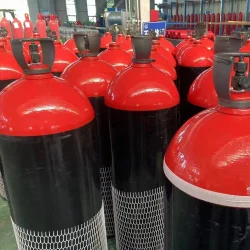Here are key aspects related to welding gas cylinders
2023-12-28
Welding gas cylinders, also known as gas tanks or bottles, are containers used to store and transport gases that are essential for various welding and cutting processes. The choice of gas depends on the specific welding method and the materials being welded. Common welding gases include oxygen, acetylene, argon, carbon dioxide, and others. Here are key aspects related to welding gas cylinders:
1. Oxygen Cylinder:
- Role: Oxygen is used as a support gas in various welding processes, including oxy-acetylene welding, cutting, and brazing.
- Color Code: In many countries, oxygen cylinders are typically colored green.
2. Acetylene Cylinder:
- Role: Acetylene is a fuel gas used in conjunction with oxygen for oxy-acetylene welding and cutting.
- Color Code: Acetylene cylinders are often colored maroon or red.
3. Argon Cylinder:
- Role: Argon is commonly used as a shielding gas in TIG (Tungsten Inert Gas) welding and as a component in some MIG (Metal Inert Gas) welding processes.
- Color Code: Argon cylinders are typically color-coded green or brown.
4. Carbon Dioxide Cylinder:
- Role: Carbon dioxide is commonly used as a shielding gas in MIG welding.
- Color Code: Carbon dioxide cylinders are usually color-coded gray.
5. Nitrogen Cylinder:
- Role: Nitrogen is used as a shielding gas in certain welding applications and is also used for purging systems.
- Color Code: Nitrogen cylinders are often color-coded black.
6. Helium Cylinder:
- Role: Helium is sometimes used as a shielding gas in specific welding processes, especially for aluminum welding.
- Color Code: Helium cylinders are typically color-coded brown.
7. Gas Cylinder Markings:
- Welding gas cylinders are marked with important information, including the type of gas, pressure rating, manufacturing details, and safety labels. This information is essential for safe handling and use.
8. Pressure Regulator:
- A pressure regulator is used to control the flow of gas from the cylinder to the welding torch. Different gases require specific regulators designed for their unique properties.
9. Safety Precautions:
- Welding gas cylinders should be stored and handled with care. They should be secured in an upright position and kept away from heat sources, flames, and electrical equipment.
- Cylinders should be regularly inspected for damage or leaks. Any damaged cylinders should be properly labeled and removed from service.
10. Transportation:
- When transporting welding gas cylinders, they should be secured in a well-ventilated area of the vehicle and properly restrained to prevent tipping or rolling.
11. Cylinder Exchange Programs:
- Many welding gas suppliers offer cylinder exchange programs, where users can exchange empty cylinders for full ones. This is a convenient way to ensure a continuous supply of gas.
It's crucial to follow safety guidelines and regulations when handling and using welding gas cylinders. Improper handling, storage, or use of these cylinders can pose serious safety risks. Always adhere to the manufacturer's instructions and industry standards to ensure the safe and effective use of welding gas cylinders.



